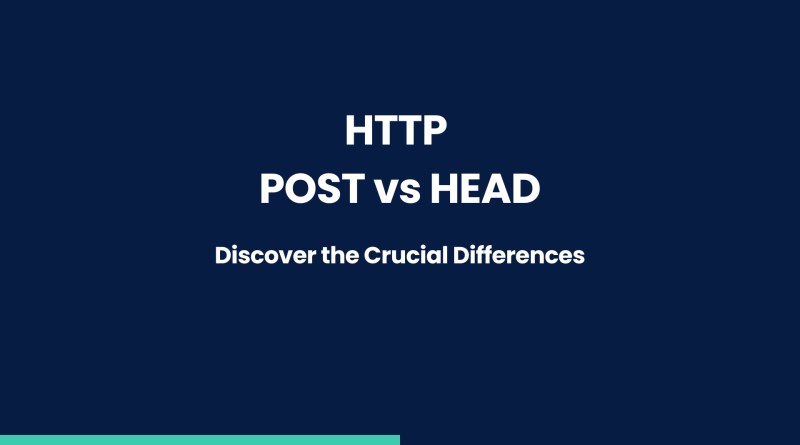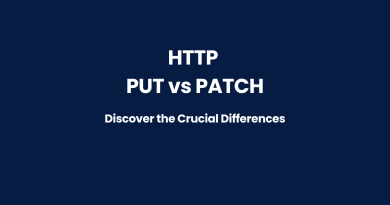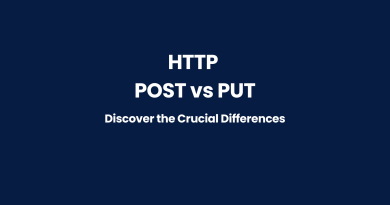HTTP POST VS HEAD: Discover the Crucial Differences
Understanding the various HTTP methods is essential for web developers, as it allows for effective and efficient communication between clients and servers. In this article, we will focus on the POST and HEAD methods, explaining their purposes, use cases, and key differences.
Definition and Purpose of HTTP POST Method
The HTTP POST method is a widely-used and versatile HTTP method designed to send data to a server in order to create or update a resource. When using the POST method, data is sent as a message body within the HTTP request. Unlike other methods such as GET and HEAD, the POST method is intended to submit data to the server, often resulting in changes to the server’s state.
The main purpose of the HTTP POST method is to create new resources or update existing ones. This functionality is especially relevant when working with web forms, APIs, and file uploads. By sending data through POST, clients can interact with servers to carry out tasks such as creating new user accounts, submitting comments, or uploading images.
Definition and Purpose of HTTP HEAD Method
The HTTP HEAD method is an essential yet often overlooked member of the HTTP family. Its primary purpose is to retrieve metadata about a resource without actually downloading the resource itself. In other words, it allows clients to request information about a resource without getting the resource’s content.
Comparing HTTP POST and HEAD
Now that we have a solid understanding of the HTTP POST and HEAD methods, it’s time to examine their similarities and differences. This comparison will help us better appreciate their unique functionalities and guide us in choosing the right method for specific tasks.
| Aspect | HTTP POST | HTTP HEAD |
|---|---|---|
| Purpose and Functionality | Submit data to server, create or update resources | Retrieve metadata without downloading resource content |
| Idempotency | Non-idempotent | Idempotent |
| Message Body Presence | Contains a message body with data | No message body |
| Impact on Server State | Can alter server state | Does not alter server state |
| Use Cases | Form submissions, file uploads, API calls | Retrieving metadata, checking resource availability, caching and performance optimization |
Similarities
Both are HTTP Methods
HTTP POST and HEAD are both methods within the HTTP protocol, which is the foundation for communication on the World Wide Web. They are part of a set of standardized actions used by clients (such as web browsers) to interact with servers.
Both used for client-server communication
Both the POST and HEAD methods play an essential role in facilitating client-server communication. They allow clients to send requests and receive responses from servers, helping establish a seamless flow of information.
Differences
Purpose and Functionality
The primary difference between POST and HEAD lies in their purpose and functionality. The POST method is designed to submit data to a server, often resulting in the creation or modification of resources. On the other hand, the HEAD method retrieves metadata about a resource without downloading its content.
Idempotency
While the HEAD method is idempotent, meaning that multiple identical requests have the same effect as a single request, the POST method is not. Submitting the same POST request multiple times can result in multiple instances of the same resource or different outcomes, depending on the server’s implementation.
Message Body Presence
Another key difference is the presence of a message body in the HTTP request. POST requests typically include a message body containing the data to be submitted to the server. In contrast, HEAD requests do not have a message body, as they only request metadata about a resource.
Impact on Server State
The POST method can alter the server state by creating or updating resources, whereas the HEAD method does not modify the server state. Since HEAD only retrieves metadata, it has no impact on the server’s resources or their state.
Choosing the Right Method for Your Application
Selecting the appropriate HTTP method for your web application is crucial for ensuring efficient communication between clients and servers. In this section, we will discuss some key factors to consider when choosing between the HTTP POST and HEAD methods.
Assessing Your Application Requirements
The first step in choosing the right method is to assess your application’s requirements. Consider the functionality you aim to achieve and the type of data you need to handle. If your application involves submitting data to a server, such as creating new resources or updating existing ones, the POST method is a suitable choice. On the other hand, if your primary goal is to retrieve metadata about resources without downloading their content, the HEAD method is the way to go.
Security Considerations
When choosing between POST and HEAD, it’s essential to consider security implications. Since POST requests can modify the server state, they may expose vulnerabilities if not handled correctly. Ensure that you implement proper server-side validation and authentication when using the POST method to protect your application from potential attacks.
In contrast, the HEAD method is generally considered safer as it does not impact the server state. However, it’s still crucial to follow best security practices, such as securing your server and monitoring for suspicious activity.
Performance Implications
Performance is another crucial factor to consider when selecting the right HTTP method. The HEAD method typically requires less bandwidth than the POST method, as it only retrieves resource metadata without downloading the resource itself. This can lead to faster response times and reduced server load.
When using the POST method, consider optimizing your application to handle data submissions efficiently, such as compressing data before transmission or implementing client-side validation to reduce unnecessary server requests.
Examples of When to Use POST or HEAD
To help you better understand when to use POST or HEAD, let’s consider some common scenarios:
- Use POST when: submitting a contact form, creating a new user account, uploading a file, or updating a user’s profile information.
- Use HEAD when: checking if a resource exists before downloading, retrieving file size or type before initiating a download, or validating cache freshness without downloading the full resource.
See Also
HTTP POST Method: Comprehensive Guide
HTTP PUT Method: Comprehensive Guide
HTTP DELETE Method: Comprehensive Guide
HTTP HEAD Method: Comprehensive Guide
HTTP OPTIONS Method: Comprehensive Guide



